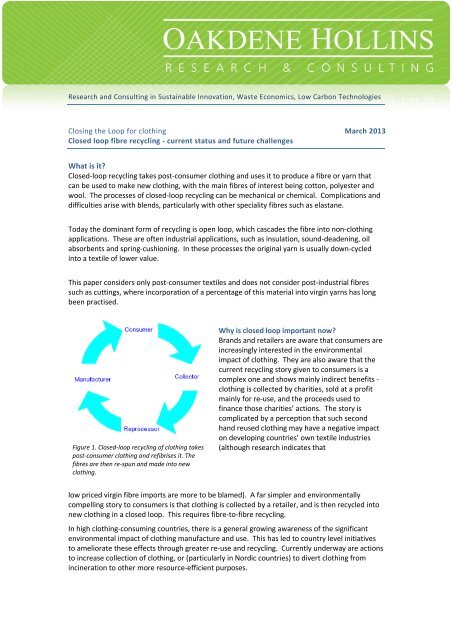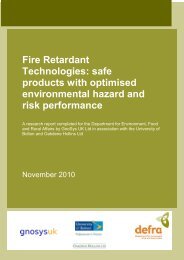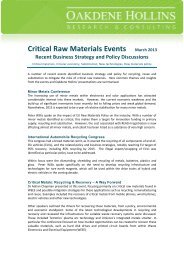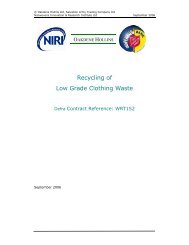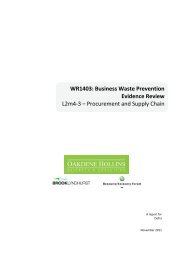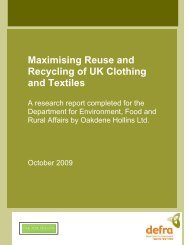Closing the Loop for clothing - Oakdene Hollins
Closing the Loop for clothing - Oakdene Hollins
Closing the Loop for clothing - Oakdene Hollins
Create successful ePaper yourself
Turn your PDF publications into a flip-book with our unique Google optimized e-Paper software.
Research and Consulting in Sustainable Innovation, Waste Economics, Low Carbon Technologies<br />
<strong>Closing</strong> <strong>the</strong> <strong>Loop</strong> <strong>for</strong> <strong>clothing</strong> March 2013<br />
Closed loop fibre recycling - current status and future challenges<br />
What is it<br />
Closed-loop recycling takes post-consumer <strong>clothing</strong> and uses it to produce a fibre or yarn that<br />
can be used to make new <strong>clothing</strong>, with <strong>the</strong> main fibres of interest being cotton, polyester and<br />
wool. The processes of closed-loop recycling can be mechanical or chemical. Complications and<br />
difficulties arise with blends, particularly with o<strong>the</strong>r speciality fibres such as elastane.<br />
Today <strong>the</strong> dominant <strong>for</strong>m of recycling is open loop, which cascades <strong>the</strong> fibre into non-<strong>clothing</strong><br />
applications. These are often industrial applications, such as insulation, sound-deadening, oil<br />
absorbents and spring-cushioning. In <strong>the</strong>se processes <strong>the</strong> original yarn is usually down-cycled<br />
into a textile of lower value.<br />
This paper considers only post-consumer textiles and does not consider post-industrial fibres<br />
such as cuttings, where incorporation of a percentage of this material into virgin yarns has long<br />
been practised.<br />
Figure 1. Closed-loop recycling of <strong>clothing</strong> takes<br />
post-consumer <strong>clothing</strong> and refibrises it. The<br />
fibres are <strong>the</strong>n re-spun and made into new<br />
<strong>clothing</strong>.<br />
Why is closed loop important now<br />
Brands and retailers are aware that consumers are<br />
increasingly interested in <strong>the</strong> environmental<br />
impact of <strong>clothing</strong>. They are also aware that <strong>the</strong><br />
current recycling story given to consumers is a<br />
complex one and shows mainly indirect benefits -<br />
<strong>clothing</strong> is collected by charities, sold at a profit<br />
mainly <strong>for</strong> re-use, and <strong>the</strong> proceeds used to<br />
finance those charities’ actions. The story is<br />
complicated by a perception that such second<br />
hand reused <strong>clothing</strong> may have a negative impact<br />
on developing countries’ own textile industries<br />
(although research indicates that<br />
low priced virgin fibre imports are more to be blamed). A far simpler and environmentally<br />
compelling story to consumers is that <strong>clothing</strong> is collected by a retailer, and is <strong>the</strong>n recycled into<br />
new <strong>clothing</strong> in a closed loop. This requires fibre-to-fibre recycling.<br />
In high <strong>clothing</strong>-consuming countries, <strong>the</strong>re is a general growing awareness of <strong>the</strong> significant<br />
environmental impact of <strong>clothing</strong> manufacture and use. This has led to country level initiatives<br />
to ameliorate <strong>the</strong>se effects through greater re-use and recycling. Currently underway are actions<br />
to increase collection of <strong>clothing</strong>, or (particularly in Nordic countries) to divert <strong>clothing</strong> from<br />
incineration to o<strong>the</strong>r more resource-efficient purposes.
Ano<strong>the</strong>r reason <strong>for</strong> <strong>the</strong> current emphasis on closed-loop is <strong>the</strong> likely increase in <strong>the</strong> quantities of<br />
re-use/recycling grade <strong>clothing</strong> collected. Although consumers in many countries are familiar<br />
with <strong>clothing</strong> collections operated (usually) by companies controlled by charities, currently<br />
disposal is often only of <strong>clothing</strong> that <strong>the</strong> consumer considers suitable <strong>for</strong> reuse 1 . However, we<br />
expect a gradual increase in <strong>the</strong> proportion of re-use and recycling grades of <strong>clothing</strong> as<br />
collection rates increase through a combination of factors including greater consumer awareness<br />
and greater opportunity, such as M&S Schwopping and H&M’s in-store collection arrangements<br />
with I:Co. As <strong>clothing</strong> collection increases, it is reasonable to expect that <strong>the</strong> quality of <strong>the</strong><br />
<strong>clothing</strong> will decrease, as consumers send <strong>for</strong> re-use or recycling <strong>clothing</strong> that <strong>the</strong>y would<br />
o<strong>the</strong>rwise have disposed of in municipal waste.<br />
Lastly, closing material loops has been given high profile through <strong>the</strong> actions of <strong>the</strong> Ellen<br />
McArthur Foundation (at a policy level) and <strong>the</strong> Cradle to Cradle approach (at a design level).<br />
Economics<br />
Financially speaking, from <strong>the</strong> perspective of a textile collection and sorting operation, recycling<br />
of <strong>clothing</strong> is much less attractive than re-use. The price of recycling grades obtained by textile<br />
sorters is usually less than <strong>the</strong> cost of <strong>the</strong> collection and sorting, but obviously better than paying<br />
<strong>for</strong> disposal, which is <strong>the</strong> only o<strong>the</strong>r option. Hence recycling is cross-subsidised by <strong>the</strong> higher<br />
prices obtained from <strong>the</strong> sale of garments <strong>for</strong> re-use.<br />
Figure 2. Shoddy production, India (Photo: Tim<br />
Mitchell)<br />
The perspective of organisations using<br />
recycled textiles is different. In developed<br />
countries most recycled fibre is sent to openloop<br />
recycling into industrial products such as<br />
mattress flocking or automotive sound<br />
deadening. Prices of <strong>the</strong>se products are highly<br />
competitive and <strong>the</strong> manufacturers rely upon<br />
cost-effective recycled raw materials to give<br />
<strong>the</strong>m an advantage over virgin raw materials<br />
which may have superior per<strong>for</strong>mance or<br />
appearance. There is potential <strong>for</strong> more<br />
recycled fibre to be absorbed by <strong>the</strong>se<br />
applications, but only at <strong>the</strong> right price. In<br />
early 2013 in <strong>the</strong> UK this means below £100<br />
per tonne.<br />
Closed loop recycling methods are already available <strong>for</strong> some textiles and depend on <strong>the</strong> fibre<br />
type and <strong>the</strong> end product. Technologically mature processes such as shoddy production in India,<br />
Morocco or Tunisia recycle used garments, while technologically advanced methods such as<br />
Teijin’s or Toray’s polyester recycling use chemical recycling to produce new yarns. There are<br />
also o<strong>the</strong>r processes under development, particularly <strong>for</strong> fibre mixes.<br />
1 See “Public Understanding of Sustainable Clothing” Research Report <strong>for</strong> Defra No. EV0405, 2008
History<br />
Closed loop recycling of <strong>clothing</strong> pre-dates<br />
<strong>the</strong> industrial open-loop applications that<br />
now dominate. Wool has historically been<br />
<strong>the</strong> most recycled fibre, partly due to its<br />
previously high market share in <strong>clothing</strong>,<br />
and partly <strong>the</strong> greater ease of fibrising <strong>the</strong><br />
knitted products in which woollens have<br />
tended to predominate. The UK West<br />
Yorkshire woollen industry actually used<br />
around 40% recovered wool at its height,<br />
with shoddy mills manufacturing a lower<br />
quality cloth often used in workwear or in carpet underlay.<br />
In Sweden Stena Recycling employed over 100 people in <strong>the</strong> fibrising of cloth, to be re-spun and made<br />
into blankets or o<strong>the</strong>r products. All of <strong>the</strong>se operations disappeared over 20 years ago due to reduced<br />
demand and lack of competitiveness. The industry now resides primarily in India, but also in some North<br />
African countries, with blankets <strong>the</strong> main product. These may be low quality emergency blankets <strong>for</strong><br />
relief operations, or more stylish patterned blankets of greater value.<br />
Some small scale fibrising and res-pinning of yarn still exists in Europe. In Prato, Italy, <strong>the</strong>re is a network<br />
of companies that use <strong>the</strong> post-industrial cuttings from primary <strong>clothing</strong> manufacture, toge<strong>the</strong>r with<br />
some <strong>clothing</strong>, to re-spin yarn. Usually this is from worsted or woollen <strong>clothing</strong>. There exist o<strong>the</strong>r<br />
isolated examples of small companies carrying out respinning in Europe.<br />
Little historical evidence exists <strong>for</strong> closed loop chemical recycling of cellulosics, although cotton linters<br />
(byproducts of cotton ginning) are used in <strong>the</strong> production of cuproammonium rayon.<br />
Chemical recycling of polyester per se has been long known and a number of possible routes exist.<br />
Chemical recycling of polyester <strong>clothing</strong> was established commercially around five years ago in Japan by<br />
Teijin.<br />
Current state of play<br />
Mechanically recycled fibre from post-consumer <strong>clothing</strong> is being used in a range of small scale initiatives.<br />
For example, a coat recently launched by M&S contains fibre from “schwopped” <strong>clothing</strong> collected in<br />
M&S stores. 2 The Dutch Jeans <strong>for</strong> Jeans 3 project was able to incorporate a percentage of recycled denim<br />
from <strong>clothing</strong> into new denim yarn.<br />
A number of corporate <strong>clothing</strong> projects have created new <strong>clothing</strong> such as hoodies or scarves from used<br />
uni<strong>for</strong>ms. In this case, <strong>the</strong> fibre mix is often polyester-wool. Although not <strong>clothing</strong>, <strong>the</strong>re have also been<br />
a number of projects producing bags and similar accessories from corporate <strong>clothing</strong> 4 .<br />
The supply chain <strong>for</strong> <strong>the</strong>se products is often small scale involving pulling and re-spinning operators<br />
working on intermittent or one-off projects. Working at a small scale with modest machinery sizes<br />
and/or slower speeds can help to retain fibre length and improve <strong>the</strong> quality of <strong>the</strong> product compared to<br />
<strong>the</strong> fibre obtained from machines set up to produce large volumes of non-wovens <strong>for</strong> industrial<br />
2 http://social.marksandspencer.com/fashion-2/sustainable-fashion-<strong>the</strong>-shwop-coat/<br />
3 http://kici.nl/en/innovate/non-wearable-textiles/recycled-jeans<br />
4 http://www.wornagain.co.uk/blogs/media
applications. Even so, <strong>the</strong>re is often a degree of quality reduction in <strong>the</strong> re-spun yarn, hence <strong>the</strong> use in<br />
scarves and coats using weave patterns where small imperfections may be more successfully hidden.<br />
Chemical recycling<br />
In chemical recycling of polyesters, Teijin have successfully extended <strong>the</strong>ir Eco Circle scheme to over 100<br />
customers in Japan, mainly corporate <strong>clothing</strong> suppliers, who send uni<strong>for</strong>ms <strong>for</strong> recycling and receive<br />
back Teijin fibre <strong>for</strong> fur<strong>the</strong>r use. The company has now established a joint venture with Jinggong Holding<br />
Group to establish polyester recycling in China using Teijin’s process, so fur<strong>the</strong>r growth is expected in <strong>the</strong><br />
Far East of this business model. In addition o<strong>the</strong>r Far Eastern polyester manufacturers such as Toray are<br />
developing competitive recycling processes. Some work is also occurring in Western Europe, although<br />
this is currently only at <strong>the</strong> laboratory scale.<br />
Cellulosic recycling is still at <strong>the</strong> developmental stage, with R&D projects at Manchester University,<br />
Renewcell 5 , Chalmers University 6 and Saxion University aiming to recycle used cotton <strong>clothing</strong> into ei<strong>the</strong>r<br />
a chemically modified (e.g. viscose) or pure cellulosic (e.g. lyocell) fibre. These projects are mostly based<br />
on pulping of <strong>the</strong> cotton and its dissolution in solvents associated with <strong>the</strong>se fibres. The Chalmers project<br />
will also consider <strong>the</strong> recycling of polycotton blends through <strong>the</strong> recycling of <strong>the</strong> polyester component.<br />
O<strong>the</strong>r parts of <strong>the</strong> recycling supply chain are gearing up <strong>for</strong> fibre recycling. For example, <strong>the</strong><br />
Textiles4Textiles project has developed a machine which sorts used <strong>clothing</strong> according to composition.<br />
This will be able to feed recycling processes <strong>for</strong> specific fibre types ra<strong>the</strong>r than end-use applications, as is<br />
<strong>the</strong> case at present.<br />
The Future<br />
The volumes of <strong>clothing</strong> collected <strong>for</strong> re-use and recycling across Europe are likely to increase due a<br />
number of factors:<br />
<br />
<br />
<br />
<br />
Continuing high prices <strong>for</strong> used <strong>clothing</strong>, in turn driven by steady demand from outside <strong>the</strong> EU (and<br />
<strong>for</strong> <strong>the</strong> best quality <strong>clothing</strong>, within <strong>the</strong> EU)<br />
Possible landfill ban extensions<br />
Possible extension of producer responsibility and a drive towards recycling away from energy<br />
recovery in Nordic countries<br />
Increasing collection rates of <strong>clothing</strong> from government and retailer initiatives such as Schwopping,<br />
H&M/I:Co, Jack Jones/I:Co and Puma in-store collection.<br />
As collection rates increase, so <strong>the</strong> percentage of lower grade <strong>clothing</strong> only suitable <strong>for</strong> recycling will also<br />
increase, since it is known that consumers are more likely to treat as rubbish <strong>clothing</strong> that <strong>the</strong>y would not<br />
wear <strong>the</strong>mselves. The rate of increase may only be slow, since countries with high collection rates such<br />
as Germany appear to have retained high levels of re-use. The retailers and brands involved in in-store<br />
collection are keen to make new <strong>clothing</strong> from old, in order to communicate a much simpler<br />
environmental message than <strong>the</strong> current recycling model, which is driven by financial advantage to a<br />
charity (although not wishing ei<strong>the</strong>r to disadvantage charities who currently benefit).<br />
The challenges to closed loop recycling are substantial. Mechanical recycling faces <strong>the</strong> problem of colour<br />
and fibre segregation currently only addressed by <strong>the</strong> (offshore) shoddy industry. In addition <strong>the</strong> suitable<br />
scale of processing in <strong>clothing</strong> is not high enough <strong>for</strong> volume recycling. Higher percentages of recycled<br />
fibre might also lead to consumer resistance owing to perceptions of reprocessed fibres being unclean.<br />
We <strong>for</strong>esee mechanical fibre-to-fibre recycling continuing to be a niche sector, with limited projects in<br />
corporate <strong>clothing</strong> recycling and also taking a small proportion of <strong>the</strong> market <strong>for</strong> larger <strong>clothing</strong> areas<br />
5 http://renewcell.se/hem/<strong>the</strong>-process.html<br />
6 http://www.mistrafuturefashion.com/en/research_program/project5/Sidor/default.aspx
such as denim. Useful projects can be carried out to bring toge<strong>the</strong>r small fibrisers and spinners to create<br />
a more integrated offering to retailers and brands <strong>for</strong> a wider range of products.<br />
We are optimistic that <strong>the</strong> development issues in cellulosic fibre recycling will be solved with <strong>the</strong><br />
application of fur<strong>the</strong>r research funding. Since most of <strong>the</strong> problems relate to <strong>the</strong> pre-treatment of<br />
cotton-containing fibres to deal with dyes, finishes and mechanical objects, we expect that this<br />
technology will start to be established with <strong>the</strong> simpler end of life cotton products that do not contain<br />
<strong>the</strong>se. Beyond this, <strong>the</strong>re is a need <strong>for</strong> funding of demonstration plants that will scale up <strong>the</strong> processes<br />
towards <strong>the</strong> 5,000-20,000 tpa that will start to be commercially interesting. The problem of blends will<br />
continue, and <strong>the</strong> economics of combining separation and recycling will make such operations difficult to<br />
establish even after technical solutions are achieved. The economics of polyester recycling will also<br />
continue to be difficult, given <strong>the</strong> scale economies and relatively low price of virgin polyester production.<br />
As <strong>the</strong> industry continues to develop, <strong>the</strong> role of automated composition analysis will become greater.<br />
Based on current recycling markets, <strong>the</strong> demand <strong>for</strong> compositional analysis is limited, but if closed<br />
material loops can be established, machinery such as that developed by Textiles4Textiles will become<br />
increasingly relevant.<br />
Although widespread uptake is still a long way off, with continued technical development and judicious<br />
re-invention we expect gradual progress towards closed loop textile recycling.<br />
For additional in<strong>for</strong>mation please contact:<br />
Nick Morley<br />
Tel: +44 (0)1296 423915<br />
Email: NMorley@oakdenehollins.co.uk<br />
<strong>Oakdene</strong> <strong>Hollins</strong>, Pembroke Court, 22-28 Cambridge Street, Aylesbury, UK, HP20 1RS<br />
About <strong>Oakdene</strong> <strong>Hollins</strong>:<br />
<strong>Oakdene</strong> <strong>Hollins</strong> is a research and consulting company working to support change toward more sustainable and less carbonintensive<br />
products, processes, services and supply chains. The company was started in 1995. The business sectors we work<br />
with include food & drink, textiles & <strong>clothing</strong>, metals & mining, wastes management, chemicals & materials, sustainable<br />
innovation and European & UK policy. We have built a strong reputation <strong>for</strong> integrity, reliability and excellence with public<br />
sector and private industry clients alike. We operate at a European scale and manage <strong>the</strong> Ecolabel scheme in <strong>the</strong> UK in<br />
collaboration with TUV/NEL.<br />
We employ people with science, economics, business administration and manufacturing disciplines, so that within each<br />
industry sector we can offer <strong>the</strong> following core services: market appraisal, technology appraisal, protocol and standards<br />
development, economic modelling, lean manufacturing projects, financial impact assessment, management of research<br />
projects, ecolabelling advice, carbon footprinting and critical review of life cycle assessments.<br />
For more in<strong>for</strong>mation about <strong>Oakdene</strong> <strong>Hollins</strong> please visit www.oakdenehollins.co.uk


